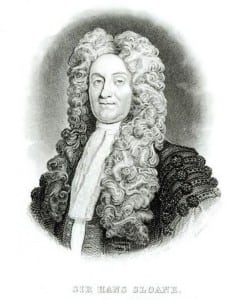Welcome to The Sloane Letters Project
 A pilot of this project, Sir Hans Sloane’s Correspondence Online, was first launched at the University of Saskatchewan in 2010 to coincide with the 350th anniversary of Sir Hans Sloane’s birth. The project was renamed The Sloane Letters Project when it moved to this site in 2016.
A pilot of this project, Sir Hans Sloane’s Correspondence Online, was first launched at the University of Saskatchewan in 2010 to coincide with the 350th anniversary of Sir Hans Sloane’s birth. The project was renamed The Sloane Letters Project when it moved to this site in 2016.
The correspondence of Sir Hans Sloane (1660-1753) consists of thirty-eight volumes held at the British Library, London: MSS 4036-4069, 4075-4078. The letters are a rich source of information about topics such as scientific discourse, collections of antiquities, curiosities and books, patients’ illnesses, medical treatments and family history. Most of the letters were addressed to Sloane, but a few volumes were addressed to others (MSS 4063-4067) or written by Sloane (MSS 4068-4069).
So far, we have entered descriptions and metadata for Sloane MSS 4036-4053 and 4075, as well as several letters from each of the following: Sloane MSS 4054-4055, 4066, 4068-4069 and 4076. Several of these entries also include transcriptions. Further entries and transcriptions are being made available gradually.
Please, explore the website and database. You can search through the letters, learn about Sir Hans Sloane or the letters written to him, and peruse blog posts about interesting letters!
Random Letter
Author:Recipient:
London, Feb. 16, 169
SIR,-I should have some time since given you my
thanks for the favour you did me in sending me one of your books of Physico-Theological Discourses; which I now do, assuring you at the same time, that you have me very much at your command and service. I have perused most part of Rauwolff’s Voyage; which being only extant in High Dutch, and that understood by very few, I thought would do well in English, and so borrowed it from the Royal Society: and Capt. Hatton being desirous of it likewise, we put it into the hands of Mr. Staphorst, who has done it as you see, I think pretty clear; though the making it good language, and the notes, are left wholly to you. Some passages are not to be well translated, because of differing customs and proverbs; but I think so far as the natural history is concerned it may be under- stood. Authors make mention of a fourth part of this work printed the next year, viz. in 1583, which is very true; for some of the plants of Rauwolff mentioned by him, and described in this journal, were engraven in wood, and without any farther descriptions, only references in the margin to the descriptions in the pages of the journal, make up a fourth of the book, or part; which, with a new title- page, was what made the second edition; the book in pages , &c., without cuts , and of the first edition in 1582, being exactly the same as with the fourth part, and cuts, in 1583. The compiler of the Historia Lugdunensis at the latter end, in an Appendix, takes all these cuts, bating some few, which had been graved in the body of that history; and adding the descriptions out of the journal to the cuts, makes that Appendix which we have at the latter end of that work. I think this work a very curious one in several natural remarks, as in the spiral cutting of the poppy-heads, in making opium, &c. I have likewise solicited hard to get one Martin’s book of Greenland trans- lated and printed. It was done into order from his mouth by Martin Fogelius of Hamburgh, and there printed 1673 in 4to, with many cuts of birds, plants, &c., of those parts, and is not extant that I hear of in any language but High Dutch. I have seen two plants form the Cape of Good Hope; they are both coniferous trees, and one has a seed pappous, or rather feathered, like the seeds of Viorna; but with those seeds of feathers sticking between the scales , it makes one of the loveliest cones I ever beheld, if you add that the leaves are covered with the longest, whitest, and thickest tomentum I sever saw, being else like to the leaves of a willow. The other cone has its seed in the middle, and not between the scales, but at top of the cone together, and it also feathered.Read more- Letter 4558
Latest Statistics
| Pages digitised | |
| 4,545 | Document summaries |
| Documents transcribed | |
| People | |
| 1,527 | Medical Cases |
| Places |